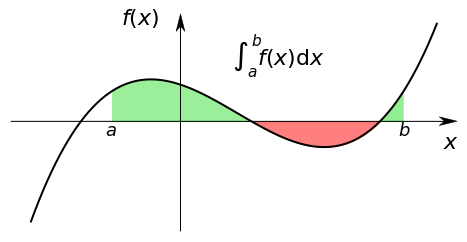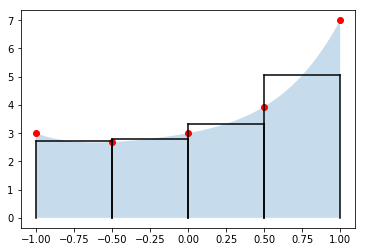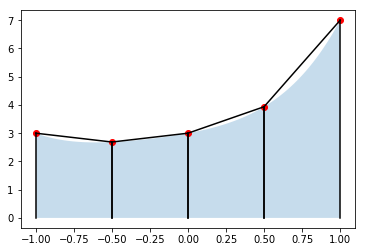Jupyter Snippet NP ch08-figures
Jupyter Snippet NP ch08-figures
Robert Johansson
Source code listings for Numerical Python - Scientific Computing and Data Science Applications with Numpy, SciPy and Matplotlib (ISBN 978-1-484242-45-2).
%matplotlib inline
import matplotlib.pyplot as plt
import numpy as np
import sympy
Integral
x, x0 = sympy.symbols("x, x_0")
f = (x+0.5) ** 3 - 3.5 * (x+0.5) **2 + x + 3
f.subs(x,x0) + f.diff(x).subs(x,x0) * (x - x0)
$\displaystyle x_{0} + \left(x - x_{0}\right) \left(- 7.0 x_{0} + 3 \left(x_{0} + 0.5\right)^{2} - 2.5\right) + \left(x_{0} + 0.5\right)^{3} - 3.5 \left(x_{0} + 0.5\right)^{2} + 3$
f_func = sympy.lambdify(x, f, 'numpy')
def arrowify(fig, ax):
xmin, xmax = ax.get_xlim()
ymin, ymax = ax.get_ylim()
# removing the default axis on all sides:
for side in ['bottom','right','top','left']:
ax.spines[side].set_visible(False)
# removing the axis labels and ticks
ax.set_xticks([])
ax.set_yticks([])
ax.xaxis.set_ticks_position('none')
ax.yaxis.set_ticks_position('none')
# wider figure for demonstration
#fig.set_size_inches(4,2.2)
# get width and height of axes object to compute
# matching arrowhead length and width
dps = fig.dpi_scale_trans.inverted()
bbox = ax.get_window_extent().transformed(dps)
width, height = bbox.width, bbox.height
# manual arrowhead width and length
hw = 1./25.*(ymax-ymin)
hl = 1./25.*(xmax-xmin)
lw = 0.5 # axis line width
ohg = 0.3 # arrow overhang
# compute matching arrowhead length and width
yhw = hw/(ymax-ymin)*(xmax-xmin)* height/width
yhl = hl/(xmax-xmin)*(ymax-ymin)* width/height
# draw x and y axis
ax.arrow(xmin, 0, xmax-xmin, 0., fc='k', ec='k', lw = lw,
head_width=hw, head_length=hl, overhang=ohg,
length_includes_head=True, clip_on=False)
ax.arrow(0, ymin, 0., ymax-ymin, fc='k', ec='k', lw = lw,
head_width=yhw, head_length=yhl, overhang=ohg,
length_includes_head=True, clip_on=False)
ax.text(xmax*0.95, ymin*0.25, r'$x$', fontsize=22)
ax.text(xmin*0.35, ymax*0.9, r'$f(x)$', fontsize=22)
fig, ax = plt.subplots(1, 1, figsize=(8,4))
xvec = np.linspace(-1.75, 3.0, 100)
ax.plot(xvec, f_func(xvec), 'k', lw=2)
xvec = np.linspace(-0.8, 0.85, 100)
ax.fill_between(xvec, f_func(xvec), color='lightgreen', alpha=0.9)
xvec = np.linspace(0.85, 2.31, 100)
ax.fill_between(xvec, f_func(xvec), color='red', alpha=0.5)
xvec = np.linspace(2.31, 2.6, 100)
ax.fill_between(xvec, f_func(xvec), color='lightgreen', alpha=0.99)
ax.text(0.6, 3.5, r"$\int_a^b\!f(x){\rm d}x$", fontsize=22)
ax.text(-0.88, -0.85, r"$a$", fontsize=18)
ax.text(2.55, -0.85, r"$b$", fontsize=18)
ax.axis('tight')
arrowify(fig, ax)
fig.savefig("ch8-illustration-integral.pdf")

Quadrature rules
from numpy import polynomial
from scipy import integrate
from scipy import interpolate
a = 0
b = 1.0
def f(x):
return np.exp(-x**2)
a = -1.0
b = 1.0
def f(x):
return 3 + x + x**2 + x**3 + x**4
x = np.linspace(a, b, 100)
xx = np.linspace(a-0.2, b+0.2, 100)
fig, (ax1, ax2, ax3) = plt.subplots(1, 3, figsize=(16, 4))
npoints = 2
npoints = 5
X = np.linspace(a, b, npoints)
ax1.plot(xx, f(xx), lw=1, color='k')
ax1.fill_between(x, f(x), color='lightgreen', alpha=0.9)
for n in range(len(X) - 1):
f_mid = f(X[n:n+2].mean())
ax1.plot([X[n], X[n]], [0, f_mid], 'b')
ax1.plot([X[n+1], X[n+1]], [0, f_mid], 'b')
ax1.plot(X[n:n+2], [f_mid] * 2, 'b')
ax1.plot(X[n:n+2].mean(), f_mid, 'xk')
i = (b-a)*f_mid
#ax1.text(-1, 7, r'$\int_{-1}^{\,1} f(x)dx \approx %f$' % i, fontsize=18)
ax1.plot(X, f(X), 'ro')
ax1.set_xlim(xx.min(), xx.max())
ax1.set_title('Mid-point rule')
ax1.set_xticks([-1, 0, 1])
ax1.set_xlabel(r'$x$', fontsize=18)
ax1.set_ylabel(r'$f(x)$', fontsize=18)
names = ["Trapezoid rule", "Simpson's rule"]
for idx, ax in enumerate([ax2, ax3]):
ax.plot(xx, f(xx), lw=1, color='k')
ax.fill_between(x, f(x), color='lightgreen', alpha=0.9)
i = 0
for n in range(len(X) - 1):
XX = np.linspace(X[n], X[n+1], idx+2)
f_interp = polynomial.Polynomial.fit(XX, f(XX), len(XX)-1)
ax.plot([X[n], X[n]], [0, f(X[n])], 'b')
ax.plot([X[n+1], X[n+1]], [0, f(X[n+1])], 'b')
XXX = np.linspace(X[n], X[n+1], 50)
ax.plot(XXX, f_interp(XXX), 'b')
F = f_interp.integ()
i += F(X[n+1]) - F(X[n])
ax.text(-1, 5.5, r'$\int_a^{\,b} f(x)dx \approx %f$' % i, fontsize=18)
ax.plot(X, f(X), 'ro')
ax.set_xlabel(r'$x$', fontsize=18)
ax.set_ylabel(r'$f(x)$', fontsize=18)
ax.set_xlim(xx.min(), xx.max())
ax.set_title(names[idx])
ax.set_xticks([-1, 0, 1])
fig.tight_layout()
fig.savefig('ch8-quadrature-rules-%d.pdf' % npoints)

# mid-point rule
(b-a) * f((b+a)/2.0)
6.0
# trapezoid rule
(b-a)/2.0 * (f(a) + f(b))
10.0
# simpsons rule
(b-a)/6.0 * (f(a) + 4 * f((a+b)/2.0) + f(b))
7.333333333333333
# exact result
integrate.quad(f, a, b)[0]
7.066666666666667
integrate.trapz(f(X), X)
7.3125
integrate.simps(f(X), X)
7.083333333333332
integrate.quadrature(f, a, b)[0]
7.066666666666666
integrate.romberg(f, a, b)
7.066666666666666
integrate.newton_cotes(2)[0]
array([0.33333333, 1.33333333, 0.33333333])
fig, ax = plt.subplots()
ax.fill_between(x, f(x), alpha=0.25)
ax.plot(X, f(X), 'ro')
for n in range(len(X) - 1):
f_mid = f(X[n:n+2].mean())
ax.plot([X[n], X[n]], [0, f_mid], 'k')
ax.plot([X[n+1], X[n+1]], [0, f_mid], 'k')
ax.plot(X[n:n+2], [f_mid] * 2, 'k')

fig, ax = plt.subplots()
ax.fill_between(x, f(x), alpha=0.25)
ax.plot(X, f(X), 'ro')
for n in range(len(X) - 1):
f_mid = f(X[n:n+2].mean())
ax.plot([X[n], X[n]], [0, f(X[n])], 'k')
ax.plot([X[n+1], X[n+1]], [0, f(X[n+1])], 'k')
ax.plot(X[n:n+2], [f(X[n]), f(X[n+1])], 'k')
